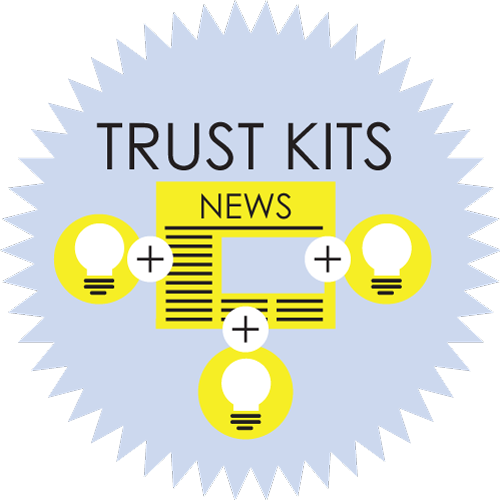FOR EDUCATORS
Today’s journalism educators are sending students into a complicated media landscape. These Trusting News Educator Trust Kits will give you research-backed strategies to help prepare students to build trust with communities. The kits have been designed to help students learn about the media and how news works while preparing students for work in a newsroom or other information-sharing position. Learn more about our goals with these kits and how to best use them here.
How students can talk about journalism and “the media”
Having an understanding of how journalism works and what “the media” is can help students navigate the complicated information space we live in while empowering them to be smart news consumers who can detect misinformation and disinformation.
Students who want to produce news and information content have a responsibility to address complaints of fake news and to explain how journalism works in order to uphold their professional integrity, educate the public, promote media literacy, and contribute to a well-informed and functioning society.
The assignments, activities and materials in this Trust Kit will help students better understand the public’s perceptions of journalism and what they can do to better explain the role and importance of credible journalism in society.
Advanced: If you’re teaching a more advanced journalism class or are looking to level-up your curriculum, we recommend checking out this advanced lesson, How to Earn Trust with Sources. The kit builds on the lessons and concepts covered here while providing activities and assignments for those students actively practicing journalism.
“I hope you aren’t doing that fake news!”
Help your students feel comfortable talking about being a journalist and explaining “the media”

Learning objectives
- Understand the job of being a journalist
- Learn about common complaints people have about “the media”
- Review data and research explaining why people have low trust in news
- Practice how to explain what journalism is and isn’t
- Learn tips for how to talk to people about “the media”

Using this in your classroom
Here are two curriculum outlines based on the provided learning objectives and in-class activities – all of which you’ll find in this Trust Kit. These curriculum outlines can be adjusted as needed to fit specific time constraints and student needs.
Expand each of the following blue boxes by clicking or tapping the + sign.
Classroom agenda: 50 minute class
Objective: Introduce students to the basics of journalism, common complaints about “the media,” and strategies for explaining and addressing mistrust in news.
- Understanding Journalism (15 minutes)
- Assign students to read What is Journalism? and watch The basics of journalism ethics before class
- Based on the readings and video discuss the key principles and values of journalism
- Common Complaints (20 minutes)
- Assign students to watch Common (mis)assumptions from news consumers and read Here’s what a newsroom survey reveals about the public’s confusion, frustration and trust before class
- Based on the readings discuss common complaints people have about “the media” and the reasons behind low trust in news
- Highlight the importance of journalism and media trust
- Use the Research on trust (collected by Trusting News) slides to highlight different areas of distrust and why it matters
- In-class Activity: Understand mistrust in news coverage (15 minutes)
Suggestion: Use the entire next class period for another in-class activity: X-Ray reading: Analyzing stories without their mastheads.
Classroom agenda: 90 minute class
Objective: Dive deeper into the topic of journalism, explore different perspectives on media trust, and engage in in-class activities.
- Understanding Journalism (15 minutes)
- Assign students to read What is Journalism? and watch The basics of journalism ethics and A day in the life of a multimedia journalist before class
- Based on the readings and video discuss the key principles and values of journalism
- Common Complaints (15 minutes)
- Assign students to watch Common (mis)assumptions from news consumers and read Here’s what a newsroom survey reveals about the public’s confusion, frustration and trust and complete and complete the “Understanding mistrust in journalism overall” assignment before class
- Based on the readings, video and assignment discuss common complaints people have about “the media” and the reasons behind low trust in news
- What the research says: (15 minutes)
- Use the Research on trust (collected by Trusting News) slides to highlight different areas of distrust and why it matters
- Highlight the importance of journalism and media trust and the impact lack of trust has on society
- In-class activity: X-Ray reading: Analyzing stories without their mastheads (45 minutes)
Suggestion: Assign students to complete the “Interview news consumers” assignment before the next class period.

Teaching materials
Use the following resources to lead your students through this curriculum. The materials include videos, articles and slideshows. All can be used during class, assigned before class or as part of assignments or discussions. These materials can be supplemented as needed to fit specific time learning objectives and student needs.
Expand each of the following blue boxes by clicking or tapping the + sign.
Student materials
- Read: What is Journalism? (Articles under “Principles of the craft” section; American Press Institute)
- Watch: The basics of journalism ethics (Trusting News)
- Watch: A day in the life of a multimedia journalist
- Review/Share: Research on trust (Slideshow)(Trusting News)
- Read: 5 things you can do to repair trust in journalism (no matter who you are) (Trusting News)
- Read: What news consumers say they trust (Trusting News)
- Read: What questions do people have about news stories? (Trusting News)
- Read: Here’s what a newsroom survey reveals about the public’s confusion, frustration and trust (Trusting News)
- Watch: Common (mis)assumptions from news consumers (Trusting News)
- Read: A case study: One TV newsroom explains how the news process works (Trusting News)
- Read: A case study: How one newsroom is fixing the “F-word news narrative” (WITF for Trusting News)
- Read: Here’s what people with low trust in news learned attending a morning news meetings (Trusting News)
- Read: Earning trust, eye-ball to eye-ball: How to respond to common complaints about journalism (Trusting News)
- Watch: Building trust face-to-face (Trusting News)
Expert materials (for educators)
The content below has been selected to help teachers and professors dive deeper and become an expert on the topic.
- Read:Trust Media and Democracy initiative (Knight Foundation and Gallup) Read: Here’s what Pew says people think of journalism and what you can do about it (Trusting News)
- Read: How newsrooms respond to common complaints people have about “the media” (Trusting News)
- Read: Build news literacy into your journalism (Trusting News)
- Read: A case study: What would happen if every journalist explained their mission (Trusting News)
- Read: A case study: What’s your why? How one newsroom shared their values to build trust and audience (Trusting News)

In-class activities
Below are in-class activities you can use to help your students better understand these topics while gaining deeper knowledge through peer interaction and hands-on learning.
Expand each of the following blue boxes by clicking or tapping the + sign.
In-class activity 1: Understand mistrust in news coverage
Divide into small groups. Assign a news organization to each group. Instruct students to review comments from the public on the news organization’s website and social media accounts and look for signals of mistrust in the people, process or integrity behind the work. Instruct students to use the questions below and be prepared to discuss what they observe with the larger class. Suggested time: 10 minutes in small groups, three minutes for each group to share
- Look for signals of mistrust or skepticism. What are some common threads? Identify two or three themes. Describe the nature of each assumption, complaint or attitude. Screenshot or quote examples from each one.
- What two or three things do you wish your specific audience or community understood about what you do?
- If the audience understood those things, how would that benefit the journalists? How would your job be easier if you were better understood?
- What would the benefits be for the audience? How would their news consumption be improved if they understood you better?
In-class activity 2: X-Ray reading — analyze stories without their brands
Thanks to Hannah Covington, former adjunct professor, for contributing this assignment.
What does trustworthy, quality journalism look like? Even the fiercest critics of “the media” can often point to a few common characteristics. News consumers say they want news that is fact-based, balanced and in-depth. They want ambitious reporting that offers multiple perspectives and captures the nuances of complex issues.
But here’s the problem: While we may know what we want from quality news, sometimes we fail to recognize these characteristics even when we see them. For example, are accusations of bias related to actual missteps and unfair distortions in stories, or are these complaints often lobbed at brands stripped across the stories? We tend to gravitate to perspectives we naturally agree with. It’s called confirmation bias, and it takes some real work to recognize our own biases so we can assess stories fairly.
For this close reading activity, we are going to put our critical thinking to work and analyze four stories on the same news event: President Trump’s rally in the summer of 2020 in downtown Tulsa. Here’s the catch: We are stripping these stories of their brands, so you’ll be assessing the articles without knowing which outlet published them. As a class, we are first going to discuss the elements that characterize quality journalism (careful attribution, multiple perspectives, fact-based claims, fairness, etc). Then, you will break into groups and put on your “X-Ray” reading glasses to decide how these stories stack up.
Stories I plan to use:
Step 1: Initial impressions. In small groups, read and discuss each story. How are they similar? How are they different? Think about their approach to covering the same event.
Step 2: X-Ray reading (with credit to Roy Peter Clark for the term). Put on your “X-Ray” reading glasses and annotate these stories in more detail, keeping an eye out for each of the elements that characterize quality journalism. Can you find multiple perspectives? Are quotes and facts carefully attributed? Is context provided? Etc.
Step 3: Share your findings. We are going to compile each group’s findings in four separate mind maps on the stories. Then, we’ll discuss your observations.
Step 4: Consider the brands. Now that we’ve completed our X-ray readings, let’s try to match which outlets you feel published which story. Then, I am going to reveal the answers. Does this information change your assessment of the article? Why or why not?
Here’s how I set up this in-class activity for students when I used it during a 50-minute class period. –Lynn Walsh

Assignments
Use the below assignments to help student gain a better understanding of the topics while practicing related skills. Each assignment has a printable Google Doc and a grading rubric.
Expand each of the following blue boxes by clicking or tapping the + sign.
Assignment 1: Understand mistrust in journalism overall
Find a printable, Google Doc of this assignment and grading rubric here.
Take a look at this collection of research on audience perceptions of journalism in the United States, then write a response. Suggestion: This would be a great discussion prompt for an online forum.
- Pick three data points from the slide deck and summarize them. Then consider how people in your own life talk about journalism and whether those experiences confirm or contradict the data points.
- Based on what you know of how journalism operates, what do you wish people knew about the news media?
Assignment 2: Interview news consumers, Part One
Find a printable, Google Doc of the assignment and grading rubric here. To build on this assignment, check out the assignment: Interview news consumers, Part Two.
There’s nothing like talking to regular people about journalism to help journalists be grounded in real perceptions, frustrations and experiences. Assign students to interview news consumers. This could be their own friends or family, a stranger or a consumer of a specific news product. Be sure to guide students through what will be done with the results (will they be published? shared with a class? anonymized?) and have them pass that on to their interview subjects.
This could stay purely qualitative. You could have students share their full answers and then also share a reflection of the experience and what they learned. You could also collect answers as a class and do an analysis of how the answers differ by things like gender, age, race and political leanings. (If you do this, please consider sharing the anonymized answers with Trusting News!)
Start with boilerplate information.
- Full name
- Email address
- Gender
- Age
- Race
- ZIP code
- What are your political leanings?
- Very conservative
- Conservative
- Moderate
- Liberal
- Very Liberal
- Other
- How many news organizations do you currently support financially through subscription, donation or membership?
- On a scale of 1-4, how likely are you to believe what you read, see or hear from mainstream journalism organizations (however you define mainstream)? 1 is very unlikely, 4 is very likely
Then move on to meaty questions.
Please try to get through at least questions 1-6. But do feel free to move beyond these questions and ask things you’re especially interested in (in general or about your news organization) as well.
- What are three sources of news you typically trust and three you don’t? Tell me about those selections.
- Can you think of a time you decided to start or stop following a specific news brand? If so, do you remember what led to that decision?
- What does quality journalism look like to you? How do you decide which news sources are credible and which are not?
- Leave this open-ended to begin with.
- Then follow up to get specific. If they say good journalism is “high quality,” “unbiased” or “objective” ask what that means. If they say they prefer nonprofit news, ask why.
- Is there anything the organizations you don’t trust could do to earn your trust?
- Do your impressions of or expectations for journalism differ between local news and national or international news?
- What do you think of journalists’ efforts to fact-check claims made by public figures? Do you believe them? Do you think they make you better informed?
- Do you notice whether journalism is labeled as analysis or opinion?
- Does that differ by medium (TV analysis and talk show segments, opinion labels on text columns)?
- In your mind, do those perspectives reflect on the overall organization, or are they separate from the straight news product?
- Do you notice the individual journalist behind a piece of work, in addition to the brand?
- Do your perceptions of an individual affect your perceptions of the news organization overall? Any examples?
- Do you feel like you can personally relate to individual journalists? If so, does that matter? Any examples?
- Do your answers differ between mediums (TV, radio, print, online)?
- Do you see concerns and issues from your own life reflected in the news?
- When you see stories you can relate to, does it affect how you perceive that news outlet?
- What do journalists often get wrong about you or things in your life (interests, demographics, etc.)?
Interview tips:
- Resist the urge to get defensive or take up too much time explaining how journalism works. Your goal is to learn from the sources and understand how they perceive news, not to convert them into fans. We hope, of course, that their interaction with you will leave them more interested in and open-minded about journalism. But we want to capture how they make news decisions BEFORE having had this conversation with you.
- Try to get beyond abstract terms like “the media” or “media bias.” Ask people to get specific about what they mean. When a term like objectivity, bias, fact-checking or transparency comes up, see if you can figure out what that means to them.
- Record audio if you can so you can focus on the conversation more than on taking notes.
- Send a note afterward thanking them for their time.
We’re here to help!
If you have questions about these kits or have used the content in your classroom and have feedback or suggestions, please contact Lynn Walsh, Lynn@TrustingNews.org.
Trusting News would like to thank the Scripps Howard Fund for funding the creation of these kits. We would also like to thank the many educators who have worked with us through the years and inspired this work.
If you would like more resources to bring into your classroom check out our other Trust Kits.


